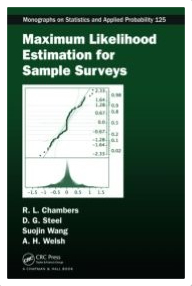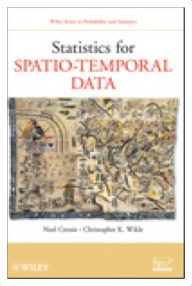 The world is becoming increasingly complex, with larger quantities of data available to be analyzed. It so happens that much of these “big data” that are available are spatio-temporal in nature, meaning that they can be indexed by their spatial locations and time stamps.
The world is becoming increasingly complex, with larger quantities of data available to be analyzed. It so happens that much of these “big data” that are available are spatio-temporal in nature, meaning that they can be indexed by their spatial locations and time stamps.
Spatio-Temporal Statistics with R by Christopher K. Wikle, Andrew Zammit-Mangion, and Noel Cressie, provides an accessible introduction to statistical analysis of spatio-temporal data, with hands-on applications of the statistical methods using R Labs found at the end of each chapter. The book:
- Gives a step-by-step approach to analyzing spatio-temporal data, starting with visualization, then statistical modeling, with an emphasis on hierarchical statistical models and basis-function expansions, and finishing with model evaluation.
- Provides a gradual entry to the methodological aspects of spatio-temporal statistics.
- Provides broad coverage of using R as well as “R Tips” throughout.
- Features detailed examples and applications in end-of-chapter Labs.
- Features “Technical Notes” throughout to provide additional technical detail where relevant.
The book fills a void in the literature and available software, providing a bridge for students and researchers alike who wish to learn the basics of spatio-temporal statistics. It is written in an informal style and functions as a down-to-earth introduction to the subject. Any reader familiar with calculus-based probability and statistics, and who is comfortable with basic matrix-algebra representations of statistical models, would find this book easy to follow. The goal is to give as many people as possible the tools and confidence to analyze spatio-temporal data.
Wikle, Zammit-Mangion and Cressie (2019) is also available as a free downloadable PDF at https://spacetimewithr.org. The website is meant to serve several purposes: It is a landing page for the book (including an associated R package STRbook); it is a place where new software, data sets, and articles on spatio-temporal statistics can be posted; and it gives publisher details where a hard-cover version can purchased from C&H/CRC Press.
Christopher K. Wikle is Curators’ Distinguished Professor and Chair of the Department of Statistics at the University of Missouri, USA.
Andrew Zammit-Mangion is a Discovery Early Career Researcher Award (DECRA) Fellow and Senior Lecturer in the School of Mathematics and Applied Statistics at the University of Wollongong, Australia.
Noel Cressie, FAA is Distinguished Professor in the School of Mathematics and Applied Statistics and Director of the Centre for Environmental Informatics at the University of Wollongong, Australia.
 The world is becoming increasingly complex, with larger quantities of data available to be analyzed. It so happens that much of these “big data” that are available are spatio-temporal in nature, meaning that they can be indexed by their spatial locations and time stamps.
The world is becoming increasingly complex, with larger quantities of data available to be analyzed. It so happens that much of these “big data” that are available are spatio-temporal in nature, meaning that they can be indexed by their spatial locations and time stamps.  Ken Russell, honorary professor in NIASRA, has written a book on the design of experiments when the data to be collected will be analysed by a generalized linear model (GLM). The book concentrates on situations where the predictor variables are ‘interval’ or ‘ratio’ in nature.
Ken Russell, honorary professor in NIASRA, has written a book on the design of experiments when the data to be collected will be analysed by a generalized linear model (GLM). The book concentrates on situations where the predictor variables are ‘interval’ or ‘ratio’ in nature. Distinguished Professor Noel Cressie contributed the chapter Environmental informatics: Uncertainty quantification in the environmental sciences.
Distinguished Professor Noel Cressie contributed the chapter Environmental informatics: Uncertainty quantification in the environmental sciences. NIASRA members Ray Chambers and David Steel have collaborated with colleagues Suojin Wang from Texas A&M University and Alan Welsh from the Australian National University to produce a book on Maximum Likelihood Estimation for Sample Surveys, which has recently been published by CRC press.
NIASRA members Ray Chambers and David Steel have collaborated with colleagues Suojin Wang from Texas A&M University and Alan Welsh from the Australian National University to produce a book on Maximum Likelihood Estimation for Sample Surveys, which has recently been published by CRC press. Ray Chambers and Robert Clark, have published a new book titled "An Introduction to Model-Based Survey Sampling with Applications".
Ray Chambers and Robert Clark, have published a new book titled "An Introduction to Model-Based Survey Sampling with Applications". Released in 2011, Distinguished Professor Noel Cressie in conjunction with Christopher K. Wikle published "Statistics for Spatio-Temporal Data", a major text in the sphere of Spatial Statistics and Environmental Statistics. The book won the 2011 PROSE Award for Professional and Scholarly Excellence in the Mathematics Category, from the Association of American Publishers.
Released in 2011, Distinguished Professor Noel Cressie in conjunction with Christopher K. Wikle published "Statistics for Spatio-Temporal Data", a major text in the sphere of Spatial Statistics and Environmental Statistics. The book won the 2011 PROSE Award for Professional and Scholarly Excellence in the Mathematics Category, from the Association of American Publishers.